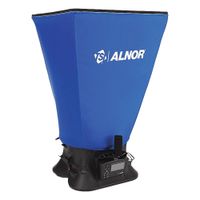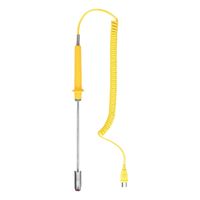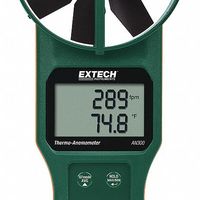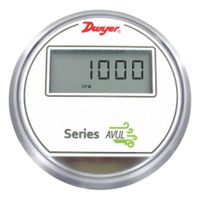Call +(254) 703 030 000 / 751 483 999 / 721 704 777
- Home
- Test Instruments
- Air Movement Quality Testing
- Air Movement Testing
.....Read More
Frequently Asked Questions
What is the best air velocity meter for HVAC systems?
The best air velocity meter for HVAC systems is the Testo 405i Hot-Wire Anemometer. This device is highly regarded for its precision, ease of use, and advanced features tailored for HVAC applications. It offers a range of benefits that make it ideal for professionals in the field:
1. **Accuracy and Range**: The Testo 405i provides accurate measurements of air velocity, temperature, and volume flow, with a velocity range of 0 to 30 m/s. This ensures precise readings necessary for efficient HVAC system diagnostics and maintenance.
2. **Wireless Connectivity**: It features Bluetooth connectivity, allowing it to pair with smartphones or tablets. This enables users to view and analyze data in real-time through the Testo Smart Probes App, enhancing convenience and data management.
3. **Portability and Design**: The compact and lightweight design makes it easy to carry and use in various settings. Its extendable telescopic probe allows for measurements in hard-to-reach areas, which is crucial for comprehensive HVAC assessments.
4. **User-Friendly Interface**: The intuitive app interface provides clear visualizations of data, including graphs and tables, making it easier to interpret results and make informed decisions.
5. **Durability and Build Quality**: Built with robust materials, the Testo 405i is designed to withstand the rigors of fieldwork, ensuring longevity and reliability.
6. **Versatility**: Suitable for a wide range of HVAC applications, including duct measurements and balancing, it is a versatile tool for professionals seeking comprehensive solutions.
Overall, the Testo 405i Hot-Wire Anemometer stands out as the best choice for HVAC professionals due to its combination of accuracy, connectivity, and user-friendly features.
How do air flow capture hoods work?
Air flow capture hoods are devices used to measure the volume of air flow from diffusers and grilles in HVAC systems. They consist of a fabric hood attached to a base with a flow meter. The hood is placed over the air outlet, capturing the air being emitted. The air is funneled through the hood to the flow meter, which measures the air volume in cubic feet per minute (CFM) or liters per second (L/s).
The hood's design ensures that the air flow is directed towards the flow meter without significant loss or turbulence, providing an accurate measurement. The flow meter typically uses a pressure sensor or anemometer to determine the velocity of the air, which is then converted into a volume measurement based on the cross-sectional area of the hood.
Some advanced models include digital displays and data logging capabilities, allowing for easy recording and analysis of air flow data. They may also have features to compensate for temperature and pressure variations, ensuring precise readings under different environmental conditions.
Air flow capture hoods are essential for balancing HVAC systems, ensuring that each space receives the correct amount of air for optimal comfort and efficiency. They help identify issues such as blockages, leaks, or incorrect system settings, facilitating maintenance and troubleshooting.
What are the benefits of using air velocity transmitters?
Air velocity transmitters offer several benefits across various applications, including HVAC systems, industrial processes, and environmental monitoring.
1. **Accurate Measurement**: They provide precise measurements of air speed, which is crucial for maintaining optimal conditions in controlled environments.
2. **Energy Efficiency**: By monitoring air velocity, these devices help optimize HVAC systems, leading to reduced energy consumption and cost savings.
3. **Improved Air Quality**: Ensuring proper air circulation and ventilation helps maintain air quality, which is vital for health and comfort in residential, commercial, and industrial settings.
4. **Process Control**: In industrial applications, air velocity transmitters are essential for controlling processes that depend on specific airflow conditions, enhancing product quality and consistency.
5. **Safety**: They help detect and prevent hazardous conditions, such as insufficient ventilation in confined spaces, which can lead to the buildup of toxic gases.
6. **Data Logging and Analysis**: Many transmitters come with data logging capabilities, allowing for historical analysis and trend monitoring, which aids in predictive maintenance and system optimization.
7. **Versatility**: These devices can be used in various environments, from clean rooms to harsh industrial settings, due to their robust design and adaptability.
8. **Integration**: Air velocity transmitters can be easily integrated into building management systems (BMS) and other control systems, providing real-time data for automated adjustments.
9. **Cost-Effectiveness**: By preventing system inefficiencies and potential failures, they contribute to long-term cost savings.
10. **Regulatory Compliance**: They assist in meeting industry standards and regulations related to air quality and safety.
Overall, air velocity transmitters are essential tools for ensuring efficient, safe, and compliant operation in numerous applications.
How do you calibrate an air velocity meter?
To calibrate an air velocity meter, follow these steps:
1. **Preparation**: Ensure the air velocity meter is clean and in good working condition. Check the manufacturer's manual for specific calibration instructions and required equipment.
2. **Select a Calibration Standard**: Use a wind tunnel or a controlled airflow source with a known and stable air velocity. The standard should be traceable to a national or international standard.
3. **Set Up the Equipment**: Position the air velocity meter in the airflow path of the calibration standard. Ensure it is aligned correctly and securely mounted to avoid movement during calibration.
4. **Stabilize the Environment**: Allow the airflow to stabilize. Ensure the temperature, humidity, and pressure are within the operational range of the meter and remain constant during calibration.
5. **Record Baseline Readings**: Measure the air velocity using the calibration standard. Record these baseline readings for comparison.
6. **Measure with the Air Velocity Meter**: Turn on the air velocity meter and take readings at the same points where the baseline readings were recorded. Ensure multiple readings are taken to account for any fluctuations.
7. **Compare and Adjust**: Compare the meter's readings with the baseline readings. If discrepancies are found, adjust the meter according to the manufacturer's instructions. This may involve using calibration software or manual adjustments.
8. **Document the Calibration**: Record all readings, adjustments, and environmental conditions. Maintain a calibration log for future reference and compliance with quality standards.
9. **Verification**: After adjustment, recheck the meter's readings against the standard to ensure accuracy. Repeat the process if necessary.
10. **Seal and Label**: Once calibrated, seal the meter to prevent tampering and label it with the calibration date and due date for the next calibration.
Regular calibration ensures the accuracy and reliability of air velocity measurements.
What is the difference between an anemometer and an air velocity meter?
An anemometer and an air velocity meter are both instruments used to measure wind speed or air flow, but they have distinct differences in design, application, and functionality.
Anemometer:
1. **Design**: Anemometers are typically designed with rotating cups, vanes, or propellers. The most common type is the cup anemometer, which consists of three or four cups attached to horizontal arms that rotate around a vertical axis.
2. **Functionality**: Anemometers measure wind speed by capturing the wind in the cups or vanes, causing them to rotate. The speed of rotation is proportional to the wind speed.
3. **Applications**: They are primarily used in meteorology, weather stations, and for wind resource assessment in wind energy projects. Anemometers are ideal for outdoor use and can measure a wide range of wind speeds.
4. **Output**: The output is usually in meters per second (m/s), kilometers per hour (km/h), or miles per hour (mph).
Air Velocity Meter:
1. **Design**: Air velocity meters often use a hot-wire or vane design. The hot-wire type uses a thin wire heated electrically, and the cooling effect of the air flow is measured to determine velocity. Vane types resemble small propeller anemometers but are more compact.
2. **Functionality**: These meters are designed to measure air flow in ducts, ventilation systems, and other controlled environments. They provide precise measurements of air velocity and sometimes temperature and pressure.
3. **Applications**: Air velocity meters are commonly used in HVAC systems, industrial applications, and laboratory settings where accurate air flow measurements are required.
4. **Output**: They provide detailed readings in m/s, ft/min, or other units, often with digital displays for easy reading.
In summary, while both devices measure air movement, anemometers are more suited for outdoor wind speed measurement, whereas air velocity meters are designed for precise indoor air flow analysis.
How do you maintain air movement testing equipment?
To maintain air movement testing equipment, follow these steps:
1. **Regular Calibration**: Ensure the equipment is calibrated regularly according to the manufacturer's specifications to maintain accuracy. Use certified calibration tools and document each calibration session.
2. **Routine Cleaning**: Clean the equipment after each use to prevent dust and debris accumulation. Use appropriate cleaning agents and tools recommended by the manufacturer to avoid damage.
3. **Inspection**: Conduct regular inspections for wear and tear. Check for any physical damage, loose connections, or worn-out parts. Replace any damaged components immediately.
4. **Battery Maintenance**: For battery-operated devices, check battery levels frequently. Replace batteries as needed and store the equipment with batteries removed if not in use for extended periods.
5. **Software Updates**: Keep the device's software updated to the latest version to ensure optimal performance and access to new features or bug fixes.
6. **Environmental Conditions**: Store the equipment in a clean, dry environment. Avoid exposure to extreme temperatures, humidity, or direct sunlight, which can affect the device's performance and longevity.
7. **Proper Handling**: Handle the equipment with care. Avoid dropping or subjecting it to mechanical shocks. Use protective cases or covers during transportation.
8. **Documentation**: Maintain detailed records of all maintenance activities, including calibration, repairs, and inspections. This helps in tracking the equipment's history and planning future maintenance.
9. **Training**: Ensure that all users are adequately trained in the operation and maintenance of the equipment. This reduces the risk of misuse and potential damage.
10. **Manufacturer Support**: Engage with the manufacturer for support and guidance on maintenance best practices. Utilize any available service contracts or warranties for professional maintenance services.
What accessories are available for air velocity meters?
Air velocity meters, also known as anemometers, come with a variety of accessories to enhance their functionality and ease of use. Common accessories include:
1. **Extension Rods**: These allow users to measure air velocity in hard-to-reach areas, such as high ceilings or deep ducts.
2. **Carrying Cases**: Protective cases are available to safely transport and store the meter and its accessories.
3. **Calibration Kits**: These kits help ensure the meter's accuracy by providing tools and standards for regular calibration.
4. **Data Logging Software**: Some meters come with or support software that allows for data logging and analysis on a computer.
5. **Wireless Connectivity Modules**: These enable the meter to connect to other devices via Bluetooth or Wi-Fi for remote monitoring and data transfer.
6. **Tripods**: For stationary measurements, tripods provide stability and precision.
7. **Temperature and Humidity Probes**: Additional probes can be attached to measure other environmental parameters alongside air velocity.
8. **Pitot Tubes**: Used for measuring air velocity in ducts, these tubes are often used in conjunction with differential pressure sensors.
9. **Replacement Sensors**: Spare sensors are available for when the original sensors wear out or need replacement.
10. **Protective Covers**: These covers protect the meter from dust, moisture, and physical damage during use.
11. **Mounting Brackets**: For fixed installations, brackets allow the meter to be securely mounted in place.
12. **USB Cables**: For meters that support data transfer, USB cables are used to connect the device to a computer.
These accessories enhance the versatility, accuracy, and convenience of air velocity meters, making them suitable for a wide range of applications in various environments.




